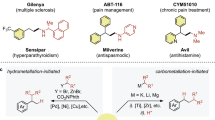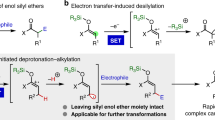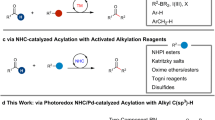Abstract
The direct anti-Markovnikov addition of strong Brønsted acids to alkenes remains an unsolved problem in synthetic chemistry. Here, we report an efficient organic photoredox catalyst system for the addition of HCl, HF and also phosphoric and sulfonic acids to alkenes, with complete regioselectivity. These transformations were developed using a photoredox catalyst in conjunction with a redox-active hydrogen atom donor. The nucleophile counterion plays a critical role by ensuring high reactivity, with 2,6-lutidinium salts typically furnishing the best results. The nature of the redox-active hydrogen atom donor is also consequential, with 4-methoxythiophenol providing the best reactivity when 2,6-lutidinium salts are used. A novel acridinium sensitizer provides enhanced reactivity within several of the more challenging reaction manifolds. This Article demonstrates how nucleophilic addition reactions mediated by photoredox catalysis can change the way electrophilic and homofugal precursors are constructed.
This is a preview of subscription content, access via your institution
Access options
Subscribe to this journal
Receive 12 print issues and online access
$259.00 per year
only $21.58 per issue
Buy this article
- Purchase on Springer Link
- Instant access to full article PDF
Prices may be subject to local taxes which are calculated during checkout



Similar content being viewed by others
References
Togo, H. Advanced Free Radical Reactions for Organic Synthesis (Elsevier, 2004).
Carey, F. A. & Sundberg, R. J. Advanced Organic Chemistry 5th edn (Springer, 2007).
Rudolph, A. & Lautens, M. Secondary alkyl halides in transition-metal-catalyzed cross-coupling reactions. Angew. Chem. Int. Ed. 48, 2656–2670 (2009).
Terao, J. & Kambe, N. Cross-coupling reaction of alkyl halides with Grignard reagents catalyzed by Ni, Pd, or Cu complexes with π-carbon ligand(s). Acc. Chem. Res. 41, 1545–1554 (2008).
Binder, J. T., Cordier, C. J. & Fu, G. C. Catalytic enantioselective cross-couplings of secondary alkyl electrophiles with secondary alkylmetal nucleophiles: Negishi reactions of racemic benzylic bromides with achiral alkylzinc reagents. J. Am. Chem. Soc. 134, 17003–17006 (2012).
Purser, S., Moore, P. R., Swallow, S. & Gouverneur, V. Fluorine in medicinal chemistry. Chem. Soc. Rev. 37, 320–330 (2008).
Smith, M. B. & March, J. in Substitution Reactions: Free Radicals in Advanced Organic Chemistry 6th edn, Ch. 14 (Wiley, 2007).
Fuller, S. E., Smith, J. R. L., Norman, R. O. C. & Higgins, R. Selectivity in the halogenation of hexane by tertiary aminium radicals from the photodecomposition of N-halogenoammonium perchlorates. J. Chem. Soc. Perkin Trans. 2, 545–552 (1981).
Kharasch, M. S. & Kleiman, M. Synthesis of polyenes. III. A new synthesis of diethylstilbestrol. J. Am. Chem. Soc. 65, 11–15 (1943).
Beller, M., Seayad, J., Tillack, A. & Jiao, H. Catalytic Markovnikov and anti-Markovnikov functionalization of alkenes and alkynes: recent developments and trends. Angew. Chem. Int. Ed. 43, 3368–3398 (2004).
Kharasch, M. S. & Mayo, F. R. The peroxide effect in the addition of reagents to unsaturated compounds. I. The addition of hydrogen bromide to allyl bromide. J. Am. Chem. Soc. 55, 2468–2496 (1933).
Mayo, F. R. Free radical addition and transfer reactions of hydrogen chloride with unsaturated compounds. J. Am. Chem. Soc. 76, 5392–5396 (1954).
Brown, H. C. & De Lue, N. R. Organoboranes for synthesis. 12. The reaction of organoboranes with nitrogen trichloride. A convenient procedure for the conversion of alkenes into alkyl chlorides via hydroboration. Tetrahedron 44, 2785–2792 (1988).
Zheng, J. et al. Synthesis of diverse well-defined functional polymers based on hydrozirconation and subsequent anti-Markovnikov halogenation of 1,2-polybutadiene. Macromolecules 45, 1190–1197 (2012).
Appel, R. Tertiary phosphane/tetrachloromethane, a versatile reagent for the chlorination, dehydration, and P–N linkage. Angew. Chem. Int. Ed. 14, 801–811 (1975).
Squires, T. G., Schmidt, W. W. & McCandlish, C. S. Jr. Zinc chloride catalysis in the reaction of thionyl halides with aliphatic alcohols. J. Org. Chem. 40, 134–136 (1975).
Furuya, T., Kuttruff, C. A. & Ritter, T. Carbon–fluorine bond formation. Curr. Opin. Drug Discov. 11, 803–819 (2008).
Dong, G., Teo, P., Wickens, Z. K. & Grubbs, R. H. Primary alcohols from terminal olefins: formal anti-Markovnikov hydration via triple relay catalysis. Science 333, 1609–1612 (2011).
Takaya, J. & Hartwig, J. F. Mechanistic studies of ruthenium-catalyzed anti-Markovnikov hydroamination of vinylarenes: intermediates and evidence for catalysis through π-arene complexes. J. Am. Chem. Soc. 127, 5756–5757 (2005).
Takemiya, A. & Hartwig, J. F. Rhodium-catalyzed intramolecular, anti-Markovnikov hydroamination. Synthesis of 3-arylpiperidines. J. Am. Chem. Soc. 128, 6042–6043 (2006).
Zhu, S., Niljianskul, N. & Buchwald, S. L. Enantio- and regioselective CuH-catalyzed hydroamination of alkenes. J. Am. Chem. Soc. 135, 15746–15749 (2013).
Hamilton, D. S. & Nicewicz, D. A. Direct catalytic anti-Markovnikov hydroetherification of alkenols. J. Am. Chem. Soc. 134, 18577–18580 (2012).
Nguyen, T. M. & Nicewicz, D. A. Anti-Markovnikov hydroamination of alkenes catalyzed by an organic photoredox system. J. Am. Chem. Soc. 135, 9588–9591 (2013).
Perkowski, A. J. & Nicewicz, D. A. Direct catalytic anti-Markovnikov addition of carboxylic acids to alkenes. J. Am. Chem. Soc. 135, 10334–10337 (2013).
Neunteufel, R. A. & Arnold, D. R. Radical ions in photochemistry. I. The 1,1-diphenylethylene cation radical. J. Am. Chem. Soc. 95, 4080–4081 (1973).
Gassman, P. G. & Bottorff, K. J. Photoinduced lactonization. A useful but mechanistically complex single electron transfer process. J. Am. Chem. Soc. 109, 7547–7548 (1987).
Pasto, D. J. & Gadberry, J. F Stereoselectivity and mechanism of acid-catalyzed additions of acetic acid to (E)- and (Z)-2-butene in acetic acid. J. Am. Chem. Soc. 100, 1469–1473 (1978).
Pearson, R. G., Sobel, H. R. & Songstad, J. Nucleophilic reactivity constants toward methyl iodide and trans-[Pt(py)2Cl2]. J. Am. Chem. Soc. 90, 319–326 (1968).
Johnston, L. J. & Schepp, N. P. Reactivity of radical cations: characterization of styrene radical cations and measurements of their reactivity toward nucleophiles. J. Am. Chem. Soc. 115, 6564–6571 (1993).
Fukuzumi, S. & Ohkubo, K. Selective photocatalytic reactions with organic photocatalysts. Chem. Sci. 4, 561–574 (2013).
Benniston, A. C. et al. Charge shift and triplet state formation in the 9-mesityl-10-methylacridinium cation. J. Am. Chem. Soc. 127, 16054–16064 (2005).
Bordwell, F. G., Zhang, X-M., Satish, A. V. & Cheng, J-P. Assessment of the importance of changes in ground-state energies on the bond dissociation enthalpies of the O–H bonds in phenols and the S–H bonds in thiophenols. J. Am. Chem. Soc. 116, 6605–6610 (1994).
O'Hagan, D. Understanding organofluorine chemistry. An introduction to the C–F bond. Chem. Soc. Rev. 37, 308–319 (2008).
Wang, J. et al. Fluorine in pharmaceutical industry: fluorine-containing drugs introduced to the market in the last decade (2001–2011). Chem. Rev. 114, 2432–2506 (2014).
Liang, T., Neumann, C. N. & Ritter, T. Introduction of fluorine and fluorine-containing functional groups. Angew. Chem. Int. Ed. 52, 8214–8264 (2013).
Olah, G. A., Masatomo, N. & Kerekes, I. Synthetic methods II1. Hydrofluorination of alkenes, cyclopropane and alkynes with poly-hydrogen fluoride/pyridine (trialkylamine) reagents. Synthesis 12, 779–780 (1973).
Bucsi, T. et al. Stable dialkyl ether/poly(hydrogen fluoride) complexes: dimethyl ether/poly(hydrogen fluoride), a new, convenient, and effective fluorinating agent. J. Am. Chem. Soc. 124, 7728–7736 (2002).
Barker, T. J & Boger, D. L. Fe(III)/NaBH4-mediated free radical hydrofluorination of unactivated alkenes. J. Am. Chem. Soc. 134, 13588–13591 (2012).
Shigehisa, H., Nishi, E., Fujisawa, M. & Hiroya, K. Cobalt-catalyzed hydrofluorination of unactivated olefins: a radical approach of fluorine transfer. Org. Lett. 15, 5158–5161 (2013).
Mangion, D. & Arnold, D. R. Photochemical nucleophile–olefin combination, aromatic substitution reaction. Its synthetic development and mechanistic exploration. Acc. Chem. Res. 35, 297–304 (2002).
Chan, M. S. W. & Arnold, D. R. Photochemical nucleophile–olefin combination, aromatic substitution (photo-NOCAS) reaction, part 15. Investigations involving fluoride anion as the nucleophile and the effect of fluorine substitution on the relative stability of the reaction intermediates. Can. J. Chem. 75, 1810–1819 (1997).
Arnold, D. R., McManus, K. A. & Chan, M. S. W. Photochemical nuclophile–olefin combination, aromatic substitution (photo-NOCAS) reaction, part 13. The scope and limitations of the reaction with cyanide anion as the nucleophile. Can. J. Chem. 75, 1055–1075 (1997).
Lin, Y-C. & Chen, C-T. Acridinium salt-based fluoride and acetate chromofluorescent probes: molecular insights into anion selectivity switching. Org. Lett. 11, 4858–4861 (2009).
Ohkubo, K. et al. Simultaneous production of p-tolualdehyde and hydrogen peroxide in photocatalytic oxygenation of p-xylene and reduction of oxygen with 9-mesityl-10-methylacridinium ion derivatives. Chem. Commun. 46, 601–603 (2010).
Franz, R. Über Trishydrofluoride tertiärer Amine und ihren Einsatz als Fluorierungsmittel. J. Fluorine Chem. 15, 423–434 (1980).
Shellhamer, D. F. et al. Reaction of aminosulfur trifluorides with alcohols: inversion vs. retention. J. Chem. Soc. Perkins Trans. 2, 973–977 (1996).
Wilger, D. J., Gesmundo, N. J. & Nicewicz, D. A. Catalytic hydrotrifluoromethylation of styrenes and unactivated aliphatic alkenes via an organic photoredox system. Chem. Sci. 4, 3160–3165 (2013).
Corbridge, D. E. C. Phosphorus: Chemistry, Biochemistry and Technology 6th edn (CRC Press, 2013).
Marziano, N. C., Sampoli, M. & Gonizzi, M. On the Mc activity coefficient function describing solute and solvent equilibria: methane sulfonic acid aqueous solutions. J. Phys. Chem. 90, 4347–4353 (1986).
Raamat, E. et al. Acidities of strong neutral Brønsted acids in different media. J. Phys. Org. Chem. 26, 162–170 (2013).
Acknowledgements
The authors acknowledge support from The David and Lucile Packard Foundation.
Author information
Authors and Affiliations
Contributions
D.J.W., J-M.M.G. and T.R.L. performed the experiments. D.A.N. guided the research. D.J.W. performed the experiments on the optimization and substrate scope for the anti-Markovnikov hydrochlorination. D.J.W. and J-M.M.G. performed the experiments on the optimization and substrate scope for the anti-Markovnikov hydrofluorination. D.J.W., J-M.M.G. and T.R.L. performed the experiments on the optimization and substrate scope for the anti-Markovnikov phosphate additions. J-M.M.G. performed the experiments on the optimization and substrate scope for the anti-Markovnikov sulfonate additions. D.J.W., J-M.M.G. and D.A.N. co-wrote the manuscript.
Corresponding author
Ethics declarations
Competing interests
The authors declare no competing financial interests.
Supplementary information
Supplementary information
Supplementary information (PDF 5801 kb)
Rights and permissions
About this article
Cite this article
Wilger, D., Grandjean, JM., Lammert, T. et al. The direct anti-Markovnikov addition of mineral acids to styrenes. Nature Chem 6, 720–726 (2014). https://doi.org/10.1038/nchem.2000
Received:
Accepted:
Published:
Issue Date:
DOI: https://doi.org/10.1038/nchem.2000
This article is cited by
-
Organophotocatalysed synthesis of 2-piperidinones in one step via [1 + 2 + 3] strategy
Nature Communications (2023)
-
Anti-Markovnikov hydrochlorination and hydronitrooxylation of α-olefins via visible-light photocatalysis
Nature Catalysis (2023)
-
Taming the radical cation intermediate enabled one-step access to structurally diverse lignans
Nature Communications (2022)
-
Catalytic remote hydrohalogenation of internal alkenes
Nature Chemistry (2022)
-
Pushing the boundaries of C–H bond functionalization chemistry using flow technology
Journal of Flow Chemistry (2020)



